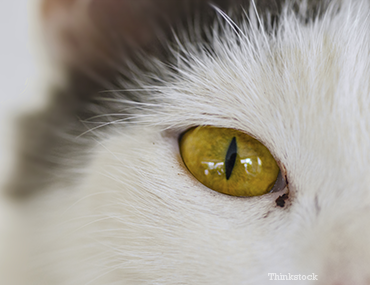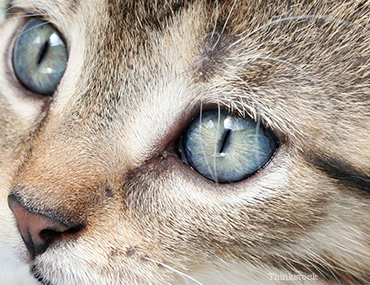
What is uveitis?
Uveitis refers to inflammation of the uveal tract of the eye. The uveal tract consists of the iris, ciliary body, and choroid. Uveitis is a painful ocular condition that can lead to blindness if untreated.
Causes of uveitis
Uveitis can be an isolated ocular problem or can be associated with a systemic disorder.
Ocular causes of uveitis in cats:

- Corneal ulceration
- Blunt trauma
- Penetrating trauma
- Ocular tumors such as iris melanoma, trauma-associated sarcoma
- Metastatic tumors
- Immune-mediated/idiopathic uveitis
Systemic disorders causing uveitis in cats:
- Viral diseases such as feline leukemia (FeLV), feline infectious virus (FIV), feline infectious peritonitis (FIP), feline herpes virus (FHV-1)
- Bacterial diseases such as bartonella, mycobacterium
- Fungal diseases such as blastomycosis, cryptococcosis, histoplasmosis, coccidiodomycosis
- Internal parasites such as toxoplasmosis
Symptoms of uveitis
- Red eye
- Cloudy eye (due to corneal edema, anterior chamber cellular reaction, or aqueous flare)
- Photophobia (light sensitivity)
- Blepharospasm (squinting)
- Third eyelid elevation
- Rubbing of the eye
Diagnosis of uveitis
The diagnosis is made clinically using either an ophthalmoscope or a handheld slit lamp to identify intraocular inflammation or other signs of uveitis. Tonometry (a test that measures the pressure inside eyes) is also performed since uveitis is usually associated with low intraocular pressure. Since uveitis may be associated with systemic disease (affecting the entire body), a complete history and thorough physical examination is also important. Additional work-up and diagnostic testing may be necessary to find the underlying cause of uveitis.

Treatment of uveitis
Treatment for uveitis depends upon the underlying cause. For infectious uveitis, the underlying infection is treated with the appropriate anti-viral, antibiotic, antifungal, or anti-parasitic medication. Additional medications may be needed to control ocular inflammation. For non-infectious uveitis, intraocular inflammation is controlled with corticosteroids and/or non-steroidal anti-inflammatory drugs (NSAIDs). Untreated uveitis can lead to any of the following:
- Blindness due to ocular complications such as glaucoma (optic nerve damage caused by elevated eye pressure)
- Cataracts (cloudiness of the lens)
- Lens subluxation (dislocation of the lens)
- Retinal detachment
- Phthisis (shrinkage and atrophy of the eyeball)
The best way to prevent vision loss is to address the underlying cause of uveitis and to treat any ocular complications. Although uveitis can be a challenging disease, by working with your veterinarian and/or veterinary ophthalmologist, uveitis can be a treatable disease.
Remember to keep an eye out for the signs and symptoms (pun intended) of uveitis. If you notice any of these or have any concerns about your pet’s eyes see your veterinarian right away. When it comes to eyes don’t mess around! Left untreated ocular issues like uveitis can lead to blindness.
If you have any questions or concerns, you should always visit or call your veterinarian -- they are your best resource to ensure the health and well-being of your pets.
